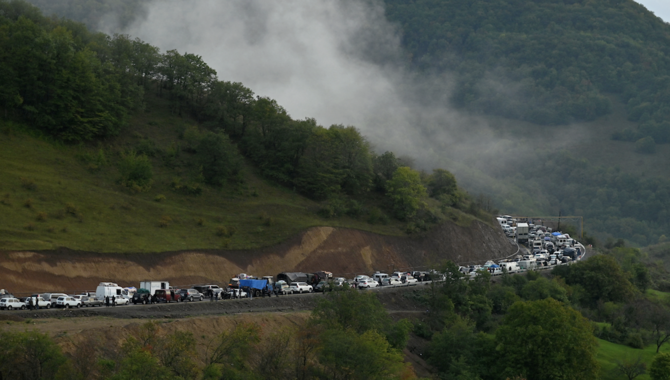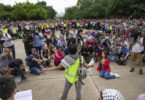Yasar Yakis
President Samvel Shahramanian on Thursday signed a decree to dissolve all state institutions of the self-declared Republic of Artsakh – aka Nagorno-Karabakh – as of Jan. 1, 2024. Against the backdrop of this news, the number of arrivals in Armenia from the region reached 65,000, which is more than half of the population. Their departure followed a short military flare-up that took place two weeks ago, when Armenian forces intensified their placement of land mines in the territory of Nagorno-Karabakh, which is internationally recognized as being part of Azerbaijan.
Other complicated international transactions took place in the meantime. The US authorities agreed to the release of €7.5 billion ($7.9 billion) of Iran’s blocked assets. In exchange for this gesture, Iran issued a statement saying that, “if Armenia is attacked, we will become part of the conflict.” It seems that something is brewing between Iran and Armenia at America’s behest. This was preceded by a joint military exercise between the US and Armenia. Washington is probably planning to use Armenia as a tool to put additional pressure on Russia in the Ukrainian war.
Whether it is unrelated or not, Armenian militants had intensified their military activities in the border area between Nagorno-Karabakh and Azerbaijan proper. The Azeri authorities warned several times that such activities would not be allowed in a territory that is part of Azerbaijan. Russian President Vladimir Putin may have sensed the US move and issued a message saying that “Karabakh is an Azerbaijani territory.”
Hopefully, the ultimate aim of the US will not be to push Turkiye, Azerbaijan, Armenia and Nagorno-Karabakh into a multilateral dispute. Foreseeing such an eventuality, Turkish President Recep Tayyip Erdogan last week proposed convening a quadrilateral meeting that would include himself, Putin, Azerbaijani President Ilham Aliyev and Armenian Prime Minister Nikol Pashinyan. When the Azerbaijani forces launched a successful anti-terrorist action two weeks ago, the military clashes took only one day. The next day, Karabakh Armenians held a meeting early in the morning and signaled that they agreed to the cessation of hostilities. They also agreed to be integrated into Azerbaijan. The negotiations will probably start soon. In fact, as they are Azerbaijani citizens, there will be no problem integrating them into the Azerbaijani population. They will benefit from the advantages of a prosperous Azerbaijan.
Demonstrators gathered in front of the government office in the Armenian capital Yerevan shouted slogans accusing the government of not being able to defend the Armenians of Nagorno-Karabakh and called for Pashinyan’s resignation. Demonstrators have also attacked the Russian Embassy in Yerevan. Pashinyan said he had received threats both from inside and outside the country. A former politician from Nagorno-Karabakh, Artak Beglaryan, wrote on social media: “Azerbaijan army blocked our defense in less than one day. A number of the strategically important positions fell in the hands of the Azerbaijani army. Most important was that the Armenians lost control of the key positions on the roads to Stepanakert. Therefore, trying to resist would have caused more casualties. What is important now is for the Armenian fighters is to draw lessons from what happened and secure the lives of the Karabakh Armenians.”
During the Second Nagorno-Karabakh War of 2020, the Azerbaijani army drew a circle around the seven provinces it liberated. In April this year, the Azerbaijani army took under its control the Lachin Corridor that used to link Armenia to Nagorno-Karabakh. It was evident that weapons and ammunition were smuggled into the region under the noses of the Russian peacekeeping forces. Independent observers believe that, when Azerbaijan’s recent anti-terror operation started, Armenian militiamen had stocks of food and ammunition that would only last for 10 days. In other words, the resistance of the Karabakh Armenians was always going to collapse sooner rather than later.
After the military clashes came to an end, the Karabakh Armenians proposed a ceasefire agreement composed of four articles. Firstly, all Armenian soldiers who stayed in the region after the 2020 war would be withdrawn. No Armenian soldier would be left in the region under the Russian peacekeeping force. Secondly, all weapons in the hands of the Nagorno-Karabakh administration would be collected and the military forces disbanded. Thirdly, all heavy weapons would be collected, taken out of the region and destroyed. And, finally, negotiations between the Nagorno-Karabakh administration and the Azerbaijani government would begin on Sept. 21 and the integration of the Karabakh people into Azerbaijan would be initiated. There were about 130,000 Armenians living in Nagorno-Karabakh at the time. The Azerbaijani authorities reportedly plan to give full citizenship status to every Armenian who lived in the region before 1992. Armenian Deputy Foreign Minister Vahan Kostanyan admitted the reality and added that the ethnic Armenian population may well continue their existence in Nagorno-Karabakh under the Azerbaijani administration.
The Russian Defense Ministry issued a statement pointing out that a comprehensive ceasefire had been secured in the area under its command and it would be implemented under the surveillance of its peacekeeping force. This may have been part of a Russian plan to dissolve the Republic of Nagorno-Karabakh. The centuries-old hostility between Azerbaijanis and Armenians may not fade away overnight but, with goodwill on both sides, their strained relations may become smoother as time goes by. One thing that is for certain is that it is now the turn of negotiators, not guns.
Arab News







